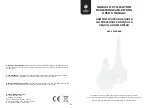
Energy must be supplied when liquid is converted
into a gas. This energy is designated as evapora-
tion heat. It does not cause any increase in tem-
perature, but is required to convert a liquid into a
gas. Conversely, energy is released when gas is
liquefied, this is designated as condensation heat.
The amount of energy from evaporation heat and
condensation heat is the same.
For water, this is: 2250 kJ/kg (4.18 kJ = 1kcal)
From this it is evident that the condensation of
water vapour causes a large quantity of energy to
be released. With drying operations, a heat cycle is
created, whereby heat is consumed for evapora-
tion and released for condensation.
Generally speaking, the time required for the
drying process is not only dependent on the
output of the unit, but is determined to a greater
extent by the speed at which the material or
building section loses its moisture.
3.2 Unit description
The units have been designed for universal and
straightforward air dehumidification.
Their compact dimensions allow the unit to be
transported and set up with ease.
The units operate in accordance with the conden-
sation principle and are equipped with a hermeti-
cally sealed refrigerant system, low-noise and low-
maintenance fan and connection cable with plug.
The fully-automated electronic controller, an inte-
grated hygrostat and connection ports for conden-
sate drainage provided by the customer ensure
continuous fault-free operation.
The units conform to the fundamental health and
safety requirements of the appropriate EU regula-
tions. The units are dependable and offer ease of
operation.
Locations at which units are used
The units are used in all locations, where dry air is
a must and where economic consequential
damage (such as that caused by mould) must be
prevented.
The units may be used for the drying and dehumid-
ification of areas such as:
n
New buildings, industrial buildings
n
Storage rooms
n
Archives, laboratories
n
Weekend homes
n
Bathrooms, wash rooms and changing rooms
etc.
n
Museums, libraries
n
Garages
Operating sequence
The unit is switched on and off using the integrated
hygrostat.
The hygrostat is set to 60 % RH in the factory. The
respective unit function is indicated by an LED dis-
play on the front of the unit.
The fan draws in the humid room air via the dust
filter on the underside of the unit. Heat is removed
from the room air on the cold evaporator. The air is
then cooled to below dew point. The water vapour
contained in the room air is then deposited as con-
densate or rime on the evaporator fins. On the
condenser, the cold and dehumidified air is
warmed up again and discharged back into the
room above the unit with a temperature increase of
around 5 K above the room temperature. The pro-
cessed, dry air therefore continuously mixes with
the room air. Continuous circulation of the room air
through the unit gradually reduces the relative
humidity (% RH) in the room to the desired
humidity level.
REMKO ETF-S Series
12













































